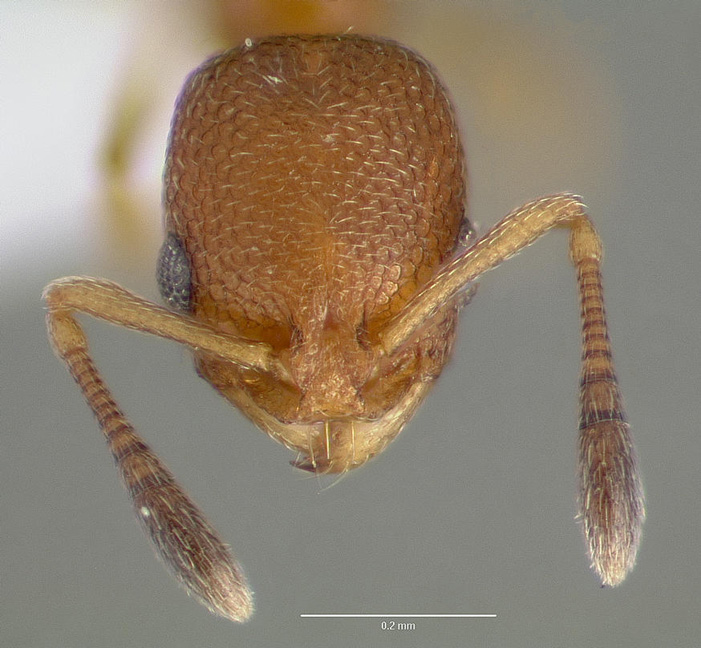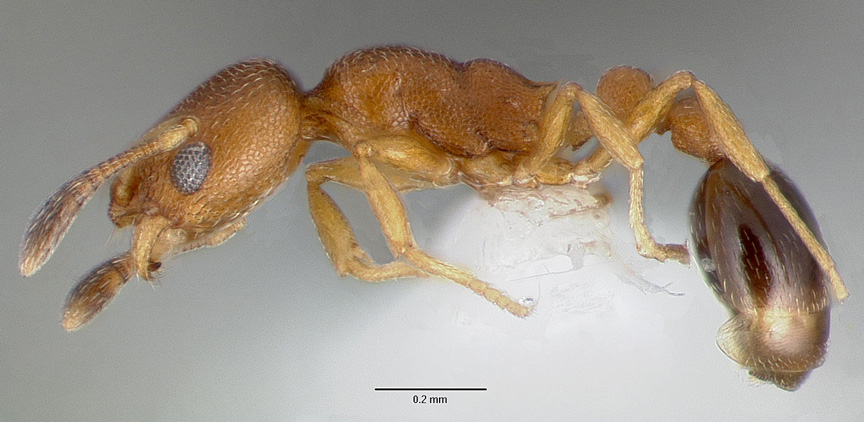Introduction
Cardiocondyla is an old world genus of omnivorous ants native to Africa and Asia. This genus includes several common tramp species that have spread globally with human commerce. Because of their small size, Cardiocondyla species are often overlooked. Colonies of most species are small (<500 workers) and are typically located in soil, especially in disturbed, open habitats near rivers, roads, forest margins, or other similar areas (Seifert 2003). However, some species also nest above ground in plant structures. Members of this genus are not generally considered to be a pest species.
Identification
Cardiocondyla workers are small to medium in size (1.5 to 3.5 mm) and yellow to dark brown. The antenna is 11 or 12-segmented and terminates in a 3-segmented club. The clypeus is flattened with lateral portions projecting outward. The promesonotal suture is lacking. Propodeal spines may be distinct or absent. For their small size, workers have a relatively large sting. Pilosity is sparse to entirely absent on the dorsum of body. In the southeastern United States, Temnothorax is the only genus that would be likely confused with Cardiocondyla. Temnothorax species in this region differ by having distinct pilosity present on the dorsum of the body.
Cardiocondyla emeryi can be differentiated from the other four species of Cardiocondyla reported from the southeastern United States by its color, which is predominately reddish brown except for the gaster and antennal club, which are dark brown; its having a distinct metanotal groove, relatively short antennal scapes; elongate head; anterior portion of the postpetiole rounded instead of concave; and relatively long propodeal spines.
Original Description
Link to paper with original description by Forel: http://128.146.250.117/pdfs/3915/3915.pdf
Biology and Economic Importance
Habitat/Nesting: Leaf litter in shade (Taylor, 2011).
Life Cycle: This species, similar to others in the genus, produces ergatoid males in addition to alate males.
Native Range: Old World Tropics, Africa
Distribution
Worldwide: Mauritius, Madeira, Canary Islands, Cape Verde Islands, St. Helena, Morocco, Israel, Egypt, Sudan, Yemen, Nigeria, Angola, Botswana, Burundi, Rwanda, Uganda, Tanzania, Cameroon, South Africa, Madagascar, Seychelles, Chagos Island, Sri Lanka, Nepal, entire Caribbean, Brazil (Seifert, 2003).
United States: Florida and Hawaii (Seifert, 2003).
Literature Cited
Seifert, B. 2003. The ant genus Cardiocondyla (Insecta: Hymenoptera: Formicidae) - a taxonomic revision of the C. elegans, C. bulgarica, C. batesii, C. nuda, C. shuckardi, C. stambuloffii, C. wroughtonii, C. emeryi, and C. minutior species groups. Ann. Naturhist. Mus. Wien. B. Bot. Zool. 104(B): 203-338.
Taylor, B. 2011. The Ants of Africa. Available online at: http://antbase.org/ants/africa/contents.htm. Accessed 14 April 2011.
Links
AntWeb
AntCat
AntWiki
Identification Guide to Invasive Ants of the Pacific Islands: Cardiocondyla emeryi
Ants of Africa: Cardiocondyla emeryi




